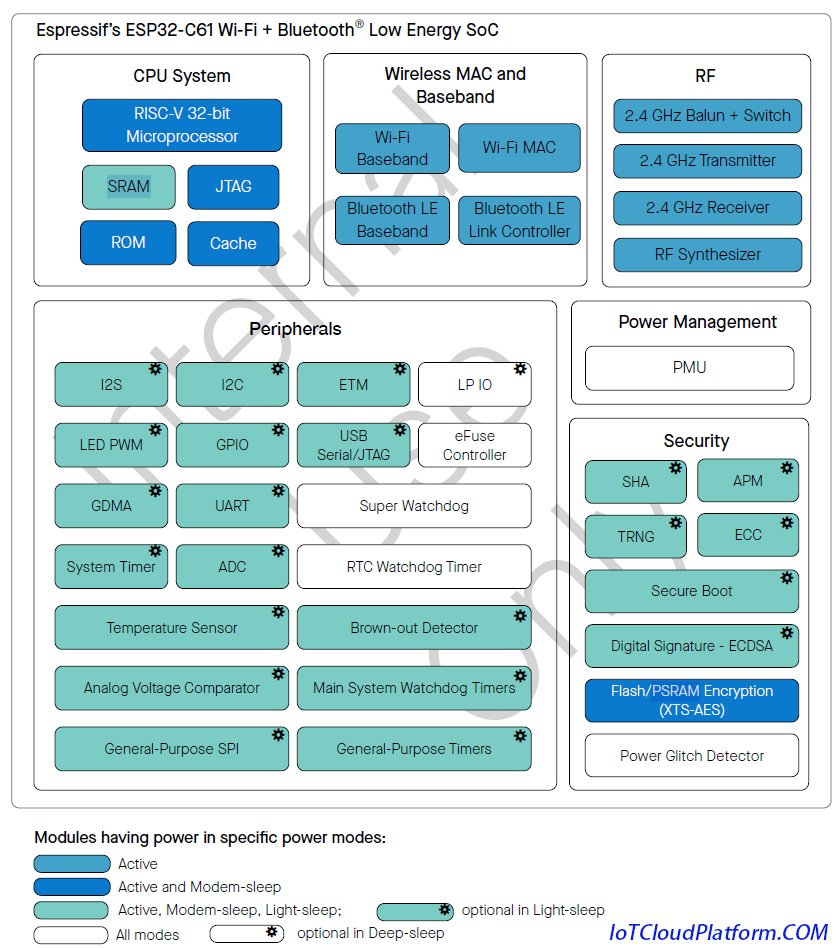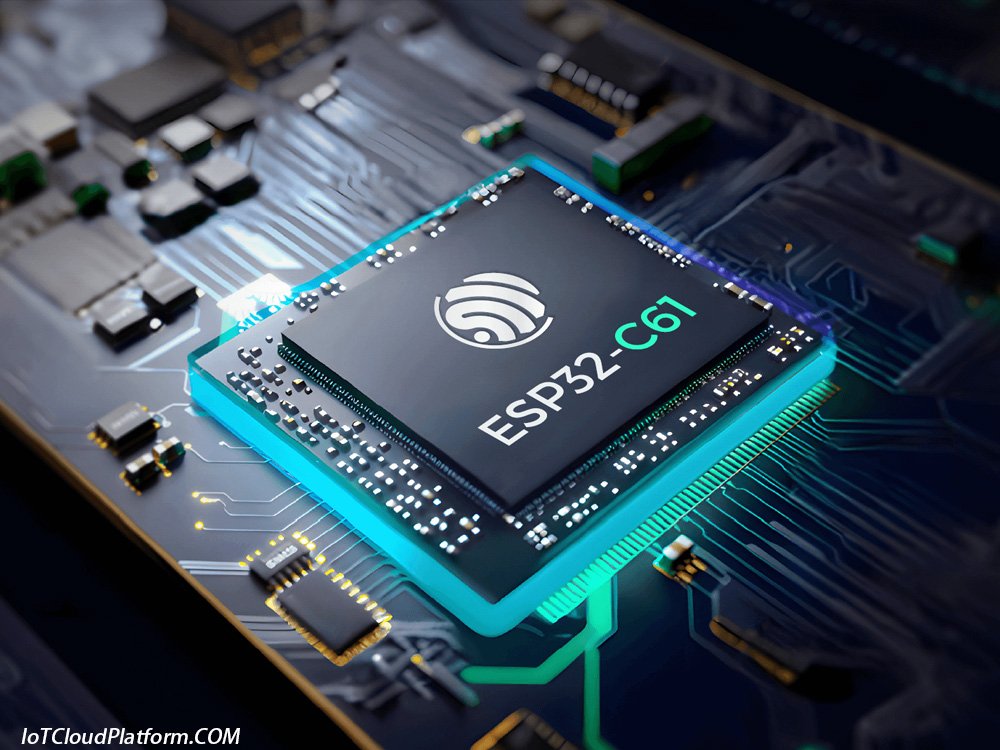
What is ESP32 C61 Espressif?
ESP32-C61 is an IoT chip that integrates high performance and low power consumption, designed to meet the needs of IoT applications such as modern smart homes, industrial automation and wearable devices.
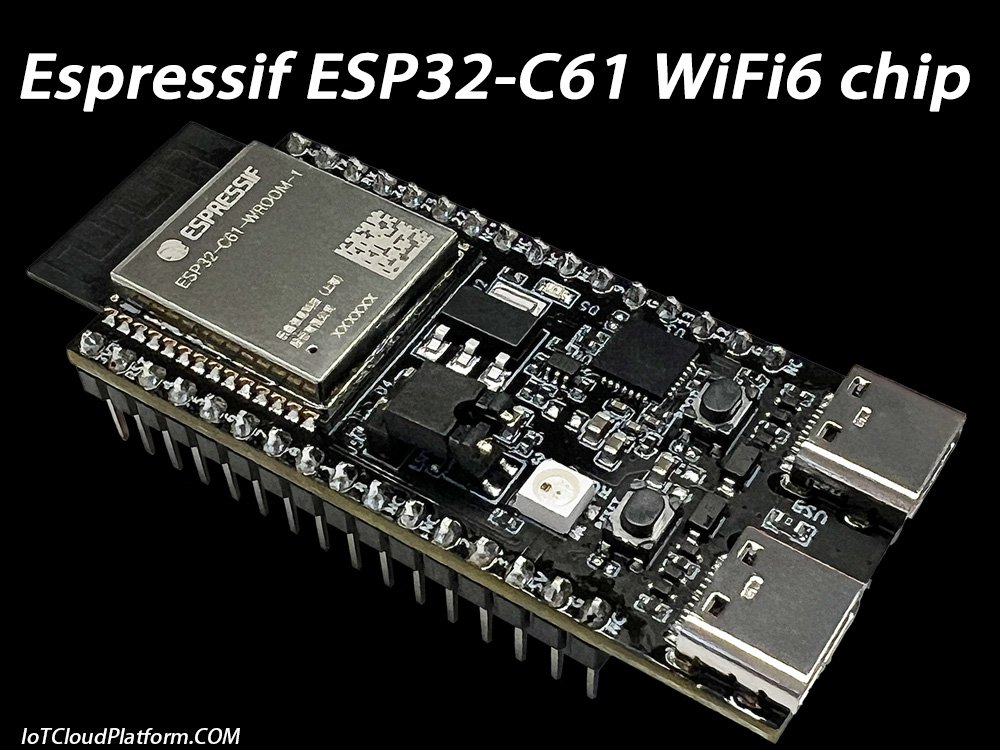
Espressif ESP32-C61 WiFi6 chip
The following is a detailed technical introduction to ESP32-C61.
Overview
ESP32-C61 is a 32-bit microcontroller (MCU) based on RISC-V architecture launched by Espressif Systems. It integrates 2.4GHz Wi-Fi 6 and Bluetooth 5 (LE) wireless communication functions, providing users with powerful connectivity and rich functional options.
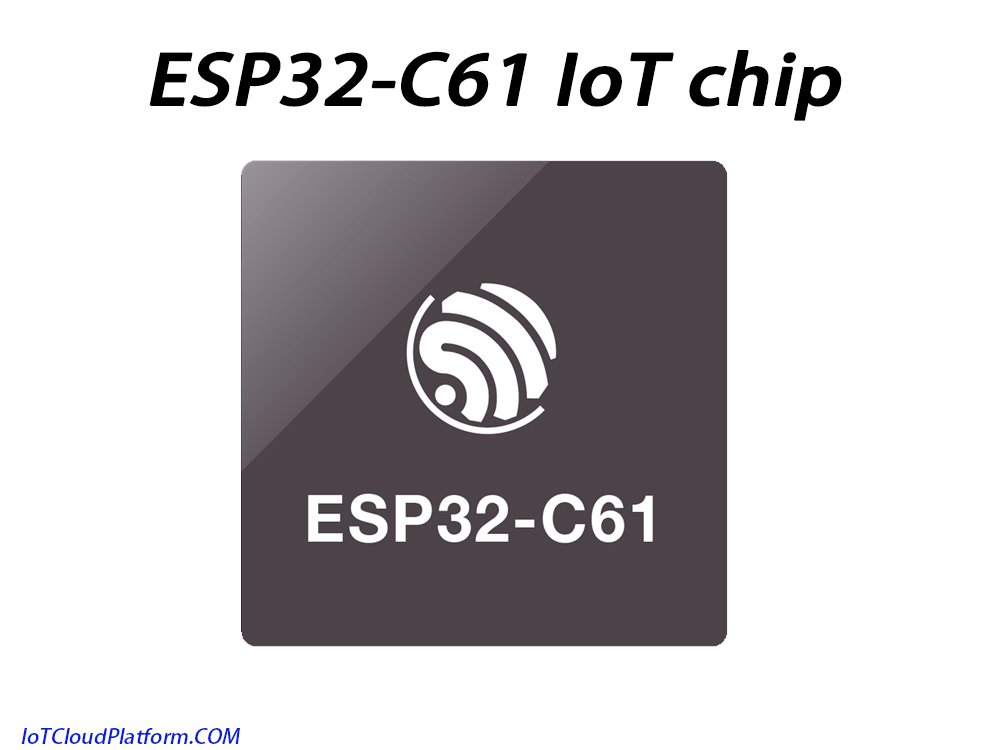
ESP32-C61 IoT chip
The chip is designed to meet the needs of IoT devices for high performance, low power consumption, high reliability and security, and is widely used in smart lighting, smart home appliances, smart speakers, smart access control, smart gateways and other fields.
Core Features
1. Processor Performance:
- ESP32-C61 is equipped with a 32-bit single-core RISC-V processor with a clock frequency of up to 160MHz, which can quickly process complex tasks and data to ensure efficient operation of the device.
- The processor supports hardware floating-point operations and DMA (direct memory access), further improving the efficiency and speed of data processing.
2. Wireless Communication Capability:
- ESP32-C61 supports the 2.4GHz Wi-Fi 6 protocol (802.11ax), providing faster transmission speeds, lower latency and higher reliability. At the same time, it is also backward compatible with the 802.11b/g/n protocol, ensuring compatibility with older devices.
- In 802.11ax mode, ESP32-C61 supports uplink and downlink orthogonal frequency division multiple access (OFDMA) access and downlink multi-user multiple output multiple input (MU-MIMO) access mechanism, which can significantly reduce latency and provide more stable connections.
- ESP32-C61 also supports Bluetooth 5 (LE) for long-distance communication based on Advertising Extensions and Coded PHY. It also supports 2 Mbps PHY for increased transmission rate and data throughput.
3. Storage and Expansion:
- ESP32-C61 has built-in 320KB on-chip SRAM and 256KB ROM, providing ample space for data storage and program execution.
- Through the Quad SPI interface, the high frequency of PSRAM can reach 120MHz, providing developers with more storage space. This is critical for IoT devices that need to store large amounts of data.
4. Security:
- ESP32-C61 integrates secure boot, flash and PSRAM encryption, and other hardware encryption accelerators to ensure the security of the device.
- It also supports ECDSA-based digital signature peripherals to ensure that private keys are protected from illegal access by software. By introducing Access Permission Management (APM) and Physical Memory Protection (PMP), ESP32-C61 creates a reliable Trusted Execution Environment (TEE) to provide flexibility for application security management.
5. Low Power Features:
- ESP32-C61 supports multiple low power modes, such as sleep mode, deep sleep mode and light sleep mode, which can flexibly adjust power consumption according to application requirements.
- It also provides a Target Wake Time (TWT) function, which is of great significance for building battery-powered IoT devices. The TWT function allows the device to enter a low power state when it does not need to transmit data, and only wake up at a predetermined time point, thereby greatly extending the device’s battery life.
6. Rich Peripheral Interfaces:
- ESP32-C61 provides a variety of standard peripheral interfaces, such as I2C, I2S, SPI, UART, LED-PWM, ADC, timer and DMA, to meet the needs of different application scenarios.
- These peripheral interfaces can connect various sensors and actuators to achieve real-time monitoring and control of the production process.
ESP32-C61 low-energy SoC WiFi Bluetooth IoT chip
Application Fields
ESP32-C61 has great potential in multiple IoT application fields due to its high performance, low power consumption, high reliability and security:
1. Smart Home:
- In the smart home system, ESP32-C61 can be used as the core processor of the smart gateway to connect and control various smart devices, such as smart bulbs, smart sockets, smart door locks, smart curtains, etc.
- Users can remotely control the devices in their home through mobile phone APP or voice assistant to achieve intelligent management and control.
2. Industrial Automation:
- In the field of industrial automation, ESP32-C61 can connect various sensors and actuators to monitor and control key parameters in the production process in real time.
- Through Wi-Fi 6 and Bluetooth 5 (LE) wireless communication functions, ESP32-C61 can transmit data to cloud servers or local control centers for analysis and processing.
3. Wearable Devices:
- The low power consumption and strong connectivity of ESP32-C61 make it an ideal choice for wearable devices.
- It can connect to various biosensors and environmental sensors to monitor the user’s health status and environmental parameters in real time, and transmit the data to the mobile phone APP or cloud server for analysis and processing.
4. Smart Security:
- In the field of smart security, ESP32-C61 can connect to cameras, smoke alarms, door and window sensors and other devices to achieve comprehensive monitoring and protection of homes or businesses.
- When an abnormal situation occurs, ESP32-C61 can send alarm information to the user’s mobile phone APP or cloud server in time to remind the user to take corresponding measures.
Development Environment and Tools
In order to facilitate developers to use ESP32-C61 for IoT application development, Espressif Information Technology provides a rich development environment and tools:
1. ESP-IDF Development Framework:
- ESP-IDF (Espressif IoT Development Framework) is the official development framework developed by Espressif for the ESP32 series chips. It provides a wealth of APIs and library functions, supports C/C++ language programming, and facilitates developers to quickly build IoT applications.
- ESP-IDF also supports a variety of development environments, such as VSCode, Eclipse, Arduino IDE, etc. Developers can choose the appropriate development environment according to their preferences and needs.
2. ESP-Matter SDK:
- ESP-Matter SDK is a software development kit developed by Espressif to support the Matter standard. Matter is a new IoT standard that aims to achieve interoperability between IoT devices of different brands and types.
- By supporting ESP-Matter SDK, ESP32-C61 can seamlessly connect and communicate with other Matter-compatible devices, providing developers with more application opportunities and market prospects.
3. Espressif Cloud Service:
- Espressif also provides a cloud service solution to help developers upload data from ESP32-C61 devices to cloud servers for storage and analysis.
- Through the cloud server, developers can achieve remote management and control of devices, as well as data visualization and analysis.
ESP32 c61 Manual
Esp development kit and master control esp32c61 PDF.
ESP8684 Series Datasheet Version 2.0 – Esp8684 technical reference manual
Summary and Outlook
ESP32-C61 is an IoT chip that integrates high performance, low power consumption and rich functions. It has great application potential in smart home, industrial automation, wearable devices and smart security.
With the continuous development and popularization of IoT technology, ESP32-C61 will become one of the preferred solutions for more IoT applications.
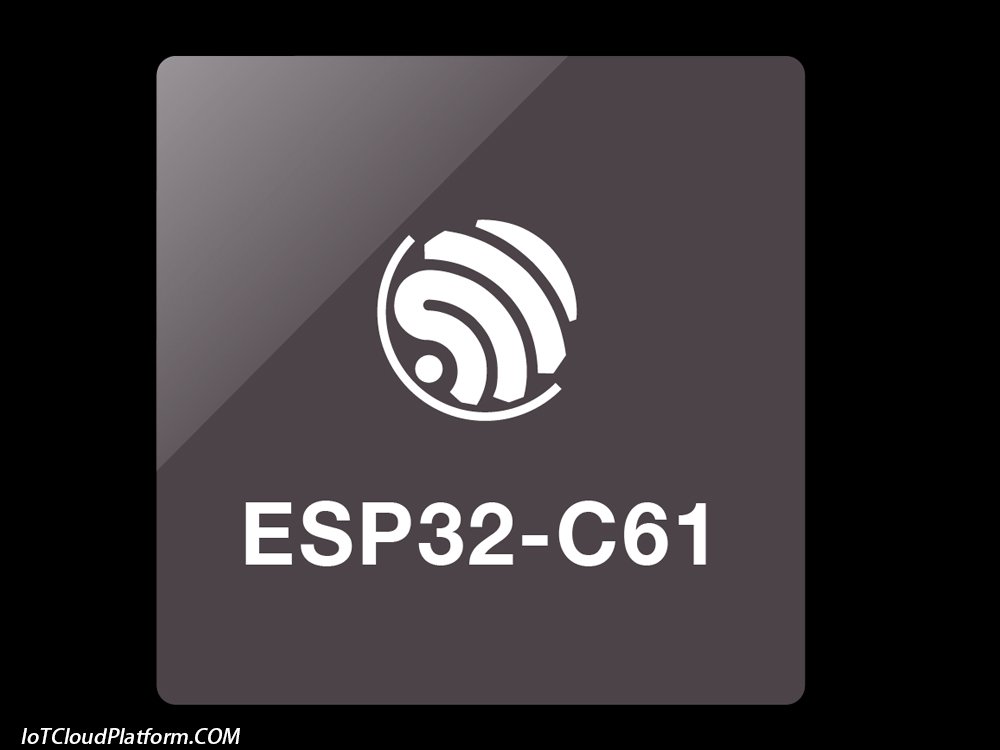
ESP32 C61 Espressif Technology WiFi6 chip for the Internet of Things industry
In the future, Espressif will continue to be committed to the research and development and innovation of IoT chips, and launch more high-performance, low-power, high-reliability and security IoT chip solutions to contribute more to the development of the IoT industry. At the same time, Espressif will also strengthen cooperation and exchanges with global partners to jointly promote the prosperity and development of the IoT industry.
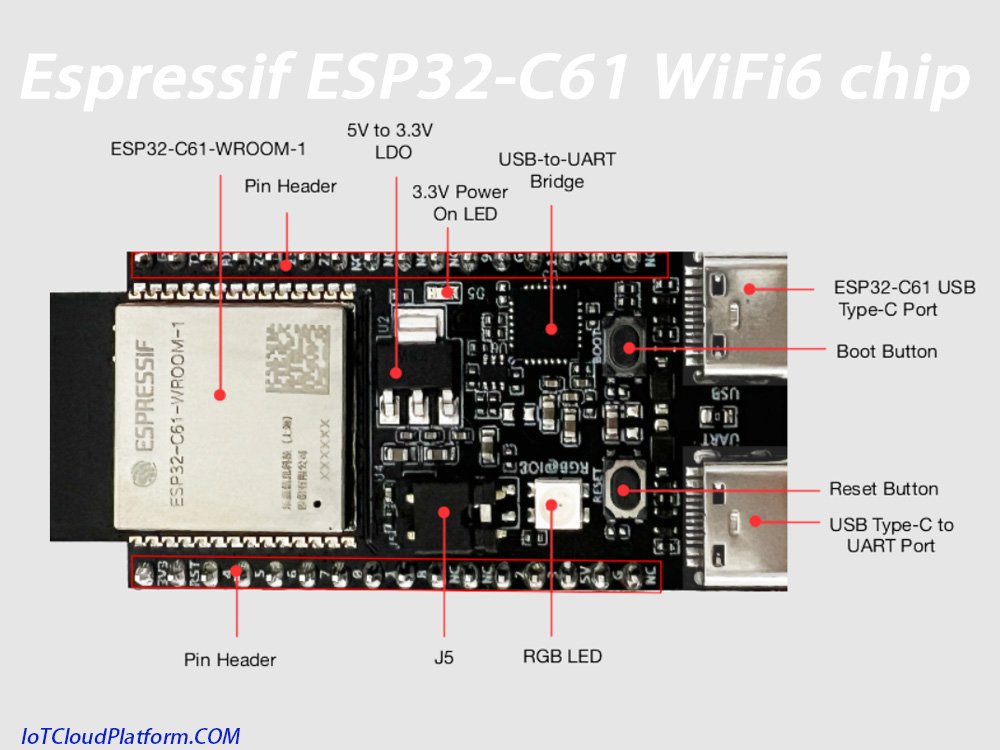
ESP32-C61-DevKitC-1 – front
About IoT Cloud Platform
IOT Cloud Platform (blog.iotcloudplatform.com) focuses on IoT design, IoT programming, security IoT, industrial IoT, military IoT, best IoT projects, IoT modules, embedded development, IoT circuit boards, IoT solutions, Raspberry Pi development and design, Arduino programming, programming languages, RFID, lora devices, IoT systems, sensors, smart homes, smart cities, new energy, semiconductors, smart hardware, photovoltaic solar energy, lithium batteries, chips and other scientific and technological knowledge.
FAQs
Here are the frequently asked questions and answers about ESP32-C61:
ESP32-C61 is a cost-effective Wi-Fi 6 chip launched by Espressif Systems, integrating 2.4 GHz Wi-Fi 6 and Bluetooth 5 (LE), designed for IoT devices.
The main features of ESP32-C61 include a high-performance RISC-V processor, support for Wi-Fi 6 and Bluetooth 5 (LE) wireless communications, rich peripheral interfaces (such as I2C, SPI, UART, etc.), built-in storage (320 KB SRAM and 256 KB ROM), support for Quad SPI flash and PSRAM expansion, and powerful security mechanisms.
ESP32-C61 was released in January 2024.
No. ESP32-C61 supports the Wi-Fi 6 (802.11ax) standard and does not support the newer Wi-Fi 7 standard.
ESP32-C61 is equipped with a 32-bit single-core RISC-V processor with a clock frequency of up to 160 MHz, which can quickly process complex tasks and data to ensure efficient operation of the device.
ESP32-C61 supports 2.4 GHz Wi-Fi 6 (802.11ax) and Bluetooth 5 (LE) wireless communication protocols. At the same time, it is also backward compatible with 802.11b/g/n protocols, ensuring compatibility with older devices.
ESP32-C61 has built-in 320 KB SRAM and 256 KB ROM, providing ample space for data storage and program execution. In addition, it also supports expansion of PSRAM through the Quad SPI interface, further improving storage capacity.
ESP32-C61 supports multiple low-power modes, such as sleep mode, deep sleep mode, and light sleep mode. At the same time, it also provides a target wake time (TWT) function, which helps to reduce the power consumption of the device and extend battery life.
ESP32-C61 integrates hardware encryption functions such as secure boot, flash and PSRAM encryption, ensuring the security of data during transmission and storage. In addition, it also supports security mechanisms such as ECDSA-based digital signature peripherals and access rights management (APM), further improving the security of the device.
ESP32-C61 supports a variety of development environments and tools, such as ESP-IDF development framework (supports C/C++ language programming), Arduino IDE, VSCode, etc. These development environments and tools provide rich APIs and library functions to facilitate developers to quickly build IoT applications.
ESP32-C61 can communicate with other devices through Wi-Fi 6 and Bluetooth 5 (LE) wireless communication protocols. At the same time, it also supports a variety of standard peripheral interfaces (such as I2C, SPI, UART, etc.), which can connect various sensors and actuators to achieve real-time monitoring and control of the production process.
ESP32-C61 is widely used in many IoT application fields, such as smart home, industrial automation, wearable devices, smart security, etc. It has become an ideal choice in these fields with its high performance, low power consumption, high reliability and security.
